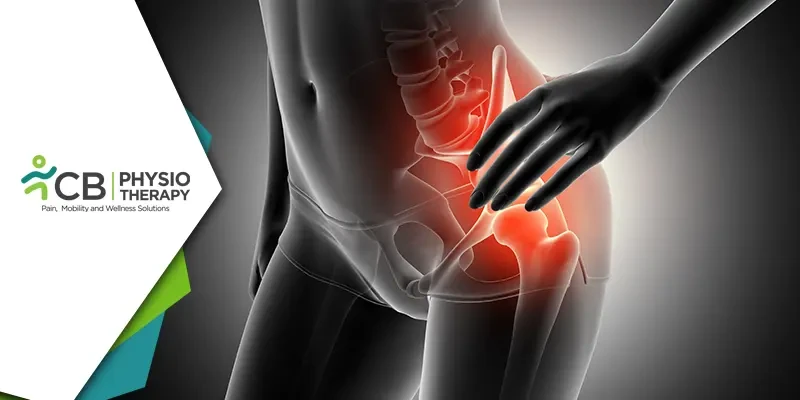Do you suffer from hip pain and feel frustrated due to it? As you are unable to walk, run or jump. Then go through this blog, to find the common causes of hip pain and ways to alleviate your pain. Hip pain is sometimes a debilitating condition that affects people of all ages and lifestyles. The hip is a complex joint that connects the thigh bone to the pelvis and is responsible for a wide range of movements. Hip pain can be caused by a variety of factors, including injuries, arthritis, and overuse.
Common Causes of Hip Pain:
Osteoarthritis: Osteoarthritis is the most common form of arthritis, and it can affect any joint in the body, including the hip. This condition occurs when the cartilage that cushions the bones in the joint wears away, leading to pain, stiffness, and reduced mobility. The pain may be felt in the groin, hip, or buttock.
Bursitis: Bursitis is a condition that occurs when the bursae, small fluid-filled sacs that cushion the joints, become inflamed. This can cause pain in the hip and other joints, particularly if the bursitis is caused by an injury or overuse.
Tendinitis: Tendinitis occurs when the tendons that attach muscles to bones become inflamed. This can be caused by overuse or an injury and can lead to pain in the hip and other joints.
Hip Fracture: A hip fracture is a serious injury that can cause severe pain in the hip, groin, or thigh. It typically occurs in older adults and requires immediate medical attention.
Muscle Strain: A muscle strain can occur when the muscles that support the hip joint become overstretched or torn. This can cause pain in the hip and other areas of the body.
Iliotibial (IT) band syndrome: Hip pain on the outside of the hip is a common complaint and can have various causes The IT band is a thick band of tissue that runs from the hip down to the knee. When the IT band becomes tight or inflamed, it can cause pain on the outside of the hip.
Hip Impingement: Hip impingement, also known as femoroacetabular impingement (FAI), is a condition where there is abnormal contact between the bones in the hip joint. This can cause pain on the inner side of the hip or groin. Hip impingement is more common in athletes and can be caused by repetitive activities such as running or jumping.
Labral Tears: The labrum is a ring of cartilage that surrounds the hip joint, providing stability and cushioning. A labral tear occurs when the labrum is torn, causing pain in the front of the hip or groin. This condition can be caused by repetitive activities, trauma, or structural abnormalities.
Sciatica: Sciatica is a condition where the sciatic nerve, which runs from the lower back down to the legs, becomes compressed or irritated. This can cause pain in the back of the hip, as well as the buttocks and legs. Sciatica is more common in adults over 40 and can be caused by spinal stenosis, herniated discs, or degenerative disc disease.
Piriformis Syndrome: The piriformis muscle is located in the buttocks and is responsible for hip rotation. When this muscle becomes tight or inflamed, it can compress the sciatic nerve, causing radiating pain in the hip, buttocks, and legs.
Physiotherapy can be an effective way to reduce hip pain by using a variety of techniques to address the underlying causes of the pain. Here are some ways physiotherapy can help reduce hip pain:
- Identification of the root cause: A physiotherapist can help identify the root cause of your hip pain by conducting a comprehensive assessment of your hip joint and the surrounding muscles and structures. This can include a range of motion and strength tests, as well as a detailed medical history and physical examination. By identifying the underlying cause of the pain, the physiotherapist can develop a personalized treatment plan that targets the specific problem.
- Manual therapy: Manual therapy is a hands-on technique used by physiotherapists to help reduce pain and improve mobility. This can include massage, joint mobilization, and stretching. By applying pressure and manipulating the soft tissues and joints around the hip joint, physiotherapists can help reduce tension, inflammation, and pain.
- Exercise therapy: Exercise therapy is a critical part of physiotherapy for hip pain. This can include exercises to improve flexibility, strength, and balance. By strengthening the muscles around the hip joint, you can improve your ability to support and stabilize the joint, reducing pain and preventing further injury.
- Electrotherapy: Electrotherapy involves the use of electrical stimulation to reduce pain and inflammation. This can include ultrasound, TENS, shockwave therapy, and other modalities. By using electrical stimulation, the physiotherapist can help reduce pain and promote healing in the tissues around the hip joint.
- Education: Education is an important part of physiotherapy for hip pain. A physiotherapist can provide advice on how to prevent further injury, such as proper posture, lifting techniques, and exercises that individuals can do at home. By understanding how to avoid activities that can aggravate the hip joint and how to perform exercises correctly, individuals can reduce the risk of further injury and pain.

